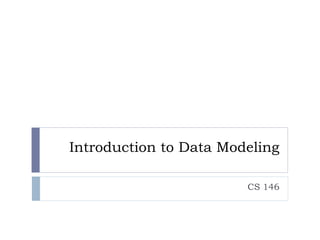
Data modelingpresentation
- 1. Introduction to Data Modeling CS 146
- 2. What is a Data Model? Definition: precise description of the data content in a system Types of data models: 1. Conceptual: describes WHAT the system contains 2. Logical: describes HOW the system will be implemented, regardless of the DBMS 3. Physical: describes HOW the system will be implemented using a specific DBMS
- 3. Why do we need to create data models? To aid in the development of a sound database design that does not allow anomalies or inconsistencies Goal: to create database tables that do not contain duplicate data values that can become inconsistent
- 4. Types of Data Models Entity-Relationship (E-R) Models Only addresses data and relationships Classic, simplest Best for deriving a sound table design Many extensions/variations exist Basis for most other modeling approaches UML (unified modeling language) Class models Goes beyond data, also models behaviors
- 5. Creating an Entity-Relationship Model 1. Identify entities 2. Identify entity attributes and primary keys 3. Specify relationships
- 6. Data Entities Entity A "thing" about which you want to store data in an application Multiple examples (instances) of the entity must exist Goal: Store data about each entity in a separate table Do not store duplicate data in multiple tables or records Examples: CUSTOMER, PRODUCT
- 7. Data Model Naming Conventions Entity names are short, descriptive, compound word singular nouns UWEC_STUDENT, CANDY_PRODUCT, Entity names will ultimately correspond to table names Why singular? Makes more sense when you start talking about relationships
- 8. Data Entity Instances Entity instance A specific occurrence (data value) of an entity An entity must have multiple entity instances or it is not really an entity! Examples: Davey Jones, Celestial Cashew Crunch
- 9. ER Model Attributes Attribute A characteristic (data field) of an entity that you want to store in the database Examples: CUST_ID, PROD_DESC Attribute value The value of a particular attribute for a particular entity instance Examples: 42, "Nuts Not Nachos"
- 10. Data Model Naming Conventions (continued) Attribute names are descriptive compound words that correspond to the entity name Attribute names will ultimately correspond to field names Every attribute name within the database should be unique
- 11. ER Model Notation Represent entities as rectangles List attributes within the rectangle Entity Attributes Primary key
- 12. Attributes Selection Issues Primary key Atomic Composite Multi-valued Derived
- 13. Primary Key Attributes Attribute whose value is unique for every entity instance Every entity MUST have a PK Designate by: Placing as first attribute in the entity Underline Label using "PK"
- 14. Selecting Primary Keys Must be values that are: Unique for every possible record Do not change Best practice: numeric with no blank spaces or formatting characters Often you need to create a surrogate key ID value that serves only to identify the object in the database Exception: objects with "natural" primary keys SKU ISBN VIN
- 15. Atomic and Composite Attributes Atomic attribute: represents a single data value 15, “Daniel", 12/25/2009 Composite attribute: can be decomposed into atomic attributes "James B. Brown" "5580 Pinewood Road, Eau Claire, WI 54701" Should you ever allow a composite attribute in a database?
- 16. Composite Attributes Decompose into atomic components for: Sorting Searching Formatting Student Student_ID Student_Name Student_Address Student_DOB Student_Class Student_First_Name Student_MI Student_Last_Name Student_Address_Line_1 Student_Address_Line_2 Student_City Student_State Student_Country Student_Postal_Code
- 17. Multi-Valued Attributes Can have multiple values for the same entity Student Student_ID (PK) Student_First_Name Student_Last_Name Student_Address Student_DOB Student_Class Student_Phone1 Student_Phone2 Employee Employee_ID (PK) Employee_First_Name Employee_Last_Name Employee_Address Employee_DOB Employee_Dependent1 Employee_Dependent2
- 18. Handling Multi-valued Attributes If it has a definite maximum number, leave as a repeating attribute If the upper limit is variable, make a new entity Student Student_ID Student_First_Name Student_Last_Name Student_Address Student_DOB Student_Class Student_Phone1 Student_Phone2 Employee Employee_ID Employee_First_Name Employee_Last_Name Employee_Address Employee_DOB Employee_Dependent1 Employee_Dependent2 Dependent Dependent_ID Dependent_Namehas
- 19. Derived Attributes Value that can be derived from other attributes Student_Age = 22 (DOB = 11/20/1986, current date is 11/13/2009) Order_Total = $500 (Item 1 cost = $200, Item 2 cost = $300)
- 20. Handling Derived Attributes Store the underlying data values from which you can derive the attribute value … Examples: DOB => Age CurrentPrice and UnitsSold of an item (for a sales order) … unless the underlying values can change! PRODUCT_PRICE, COURSE_CREDITS
- 21. Creating an Entity-Relationship Model 1. Identify entities 2. Identify entity attributes and primary keys 3. Specify relationships
- 22. Data Model Relationships Specify the number of instances of one entity that can be associated with instances of a related entity Types: 1:M 1:1 M:M “M” denotes some value greater than 1 whose upper bound is undetermined This is called relationship cardinality
- 23. Example 1:M Relationship Video_ID Video_Title Video_Format 1000 The Princess Bride DVD 1001 Sideways Bluray 1002 Just Visiting DVD 1003 Crash Bluray Store_ID Store_Name Store_Address 1 Northside 3233 Wisconsin St. 2 Southside 4211 Golf Road Store Store_ID Store_Name Store_Address Video Video_ID Video_Title Video_Format Rents
- 24. Example 1:1 Relationship Spouse_ID Spouse_Name 52 Ryan, Judy 53 Redmann, Rudy Customer_ ID Customer_ Name Customer_Address 1 Ryan, Paul 5454 Hyde Court 2 Myers, Mary 112 Birch Place Customer Customer_ID Customer_Name Customer_Address Spouse Spouse_ID Spouse_Name Has
- 26. Example ER Model
- 27. Summary: The Data Modeling Process Define entities Define attributes Define relationships Identify relationship cardinality (1:1, 1:M, M:M)